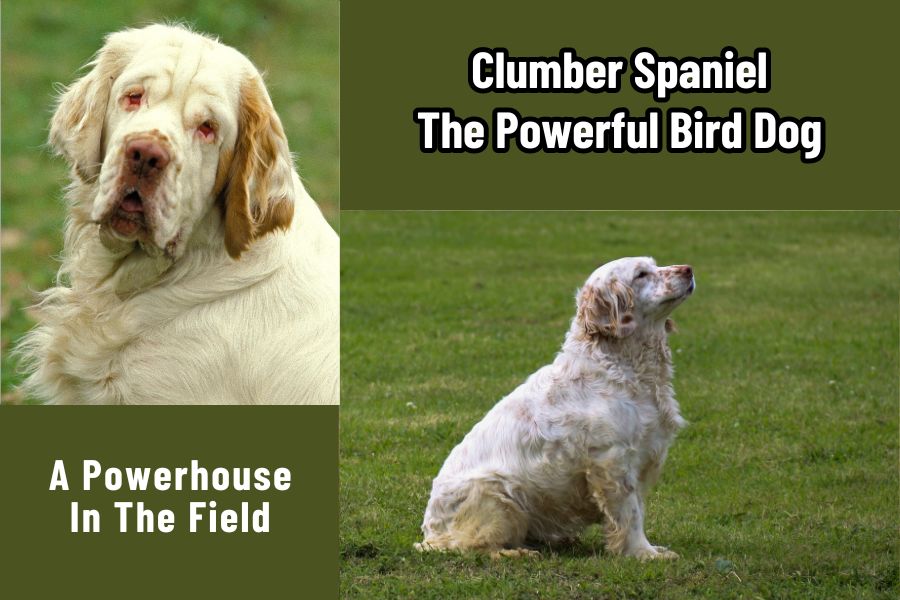Clumber Spaniel, explore their origins, distinctive traits, essential training tips, and why they excel as powerful bird dogs and loyal companions.
Introduction
Imagine a dog with a noble, powerful presence, trotting through the fields with a determination and grace that commands attention. The Clumber Spaniel, with its robust build and soulful eyes, isn’t just a remarkable sight; it’s a powerhouse in the field. Known for its incredible scenting ability and steadfast nature, this breed has carved a niche as a reliable and hardworking bird dog.
Whether you’re an avid hunter seeking a dependable partner in the field or just eager to learn more about this unique breed, this post is tailored for you. Let’s dive in to uncover more about this unique and fascinating breed.
Clumber Spaniel: Origin and History

The Clumber Spaniel, with its rich history and noble lineage, is a breed shrouded in mystery and elegance. Exploring its origin and history offers a glimpse into the fascinating journey of this powerful bird dog.
Ancestors
The Clumber Spaniel’s origins trace back to the late 18th century, but the exact details are somewhat murky. One popular theory suggests that the breed was developed in France and later brought to England by the Duke of Newcastle during the French Revolution. This theory posits that the Duke, seeking refuge for his prized dogs, relocated them to Clumber Park in Nottinghamshire, England, thus giving the breed its name.
Another theory holds that the breed was developed directly at Clumber Park by crossing Basset Hounds, Alpine Spaniels, and other early spaniel breeds to create a gun dog with a powerful nose and sturdy build, ideal for hunting in dense underbrush. Regardless of the exact origin, the purpose of the Clumber Spaniel mix remains the same today: to assist in hunting game birds with exceptional endurance and olfactory skills.
Evolution
Throughout the 19th century, the Clumber Spaniel became a favorite among British nobility, including Prince Albert and King Edward VII, who popularized the breed in royal hunting circles. By the mid-1800s, the breed was firmly established, known for its slow, deliberate hunting style and impressive scenting ability.
The name “Clumber Spaniel” indeed comes from Clumber Park, where the breed’s characteristics were honed and refined. Over the decades, Clumber Spaniels have remained relatively unchanged, preserving their unique blend of power, steadiness, and precision.
Breed Status
Today, the Clumber Spaniel is a cherished but relatively a rare breed. In the United States, the breed is recognized by the American Kennel Club (AKC), and there are an estimated 200-300 Clumber Spaniels registered annually. Worldwide, the numbers are similarly modest, with the breed maintaining a small but dedicated following in the UK, Canada, and other countries.
Despite its rarity, the Clumber Spaniel is thriving in the circles that appreciate its distinct qualities. The breed’s scarcity in North America can be attributed to its specialized role and the commitment required from owners to meet its exercise and grooming needs.
Kennel Clubs
The Clumber Spaniel has been recognized by several major kennel clubs over the years:
- AKC – American Kennel Club (USA): Recognized in 1884, the Clumber Spaniel was one of the first breeds registered by the AKC.
- UKC – United Kennel Club (USA): The breed was recognized in 1914, emphasizing its working dog qualities.
- TKC – The Kennel Club (UK): Officially recognized in 1859, the breed enjoys a storied history in the UK.
- CKC – Canadian Kennel Club (Canada): Recognized in 1888, the Clumber Spaniel is part of the Sporting Group in Canada.
Other notable clubs include the Clumber Spaniel Club (UK) established in 1904 and the Clumber Spaniel Club of America established in 1972. Both play a significant role in preserving and promoting the breed.
Clumber Spaniel In Action
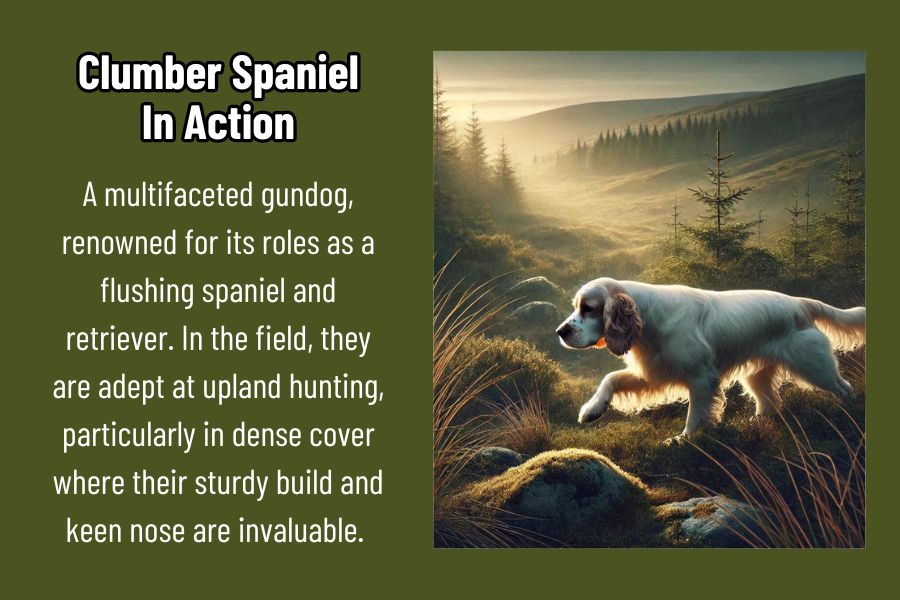
The Clumber Spaniel is not only a powerful and steady companion but also a versatile worker. This section explores the various roles where they excel, particularly in hunting and other specialized tasks.
Hunting Dog
Clumber Spaniel’s are multifaceted spaniel dogs, renowned for their gun dog roles as a flushing spaniel and a retriever. In the field, Clumber Spaniels are adept at upland hunting, particularly in dense cover where their sturdy build and keen nose are invaluable. This breed specializes in hunting game birds such as pheasant and partridge, both in small packs and when working solo.
The Clumber Spaniel hunting process is methodical and effective. It begins by using its excellent scenting ability to locate game hidden in thick cover. Once the game is located, the Clumber Spaniel flushes it out, making it easy for the hunter to take a shot. After the bird is down, their retrieving skills come into play. On command, the dog finds the shot bird and carefully with is soft mouth picks up the game and takes it back to the hunter. Their deliberate pace locating, flushing and retrieving game make them exceptional for working in challenging terrains.
Other Roles
Beyond hunting, the Clumber Spaniel excels in several other important roles. Their keen sense of smell and determination make them excellent candidates for search and rescue missions and detection work, thanks to their powerful olfactory capabilities. Their gentle and calm demeanor allows them to thrive as therapy dogs, providing comfort and companionship to those in need. Additionally, Clumbers also shine in the show ring, where their distinctive appearance and dignified presence consistently earn them accolades.
Clumber Spaniel Physical Traits
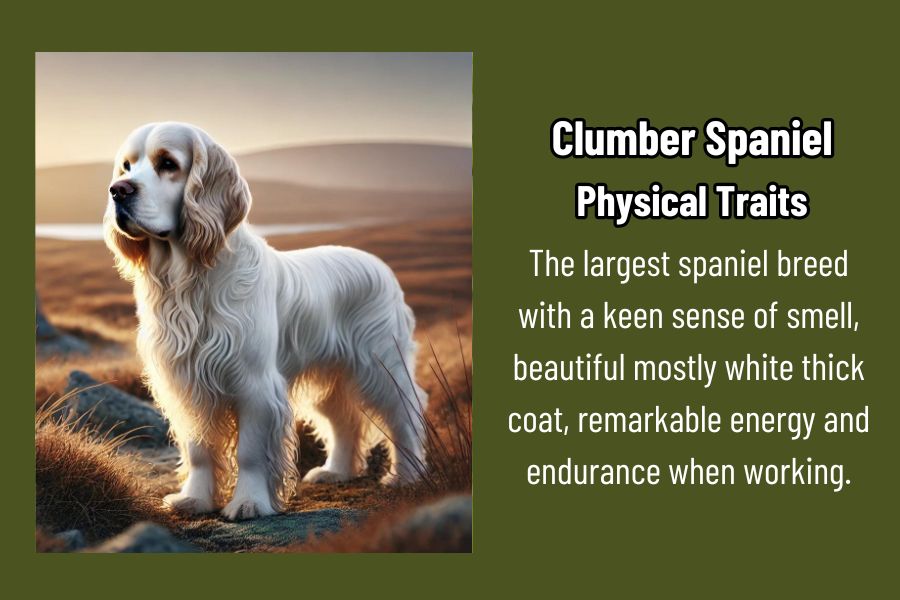
Known for being a formidable hunting companion and a great family dog, these unique physical traits define the Clumber Spaniel.
Good Swimmer
Clumber Spaniels are generally strong swimmers, a skill particularly useful for hunting waterfowl. Their large feet and strong, muscular build allow them to navigate water with ease. The breed’s dense, water-resistant coat also aids in their swimming prowess, keeping them buoyant and warm in cold water.
Size (Length and Height)
Clumber Spaniel size, they are one of the largest spaniel breeds. Males typically stand 17 to 20 inches tall at the shoulder, while females range from 16 to 19 inches. In terms of length, they are slightly longer than they are tall, contributing to their robust and sturdy appearance. This size allows them to move through thick underbrush and rough terrain with confidence and stability.
Head and Muzzle (Soft Mouth)
The Clumber Spaniel’s head is broad and massive, with a distinct stop and a well-defined brow. Their muzzle is square and strong, but one of their most notable features is their “soft mouth.” This means they can carry game without damaging it, a crucial trait for a retriever. Their large, soulful eyes and drooping ears give them a gentle and intelligent expression.
Body Structure and Weight
Clumber Spaniels have a solid, rectangular body structure that is well-muscled and heavy-boned. Males typically weigh between 70 and 85 pounds, while females weigh between 55 and 70 pounds. Their low, powerful stance is designed for endurance and strength, making them well-suited for long days in the field.
Coat Type and Colors
The Clumber Spaniel’s coat is dense, straight, and weather-resistant, providing excellent protection against the elements. The coat is primarily white, often with lemon or orange markings on the head, ears, and sometimes the body. This coloration helps them blend into various hunting environments while remaining visible to their handlers.
Keen Senses
Clumber Spaniels possess exceptionally keen senses, particularly their sense of smell. This makes them adept at locating game birds hidden in dense cover. Their hearing is also acute, allowing them to pick up on subtle sounds in their environment, further aiding in their hunting capabilities.
Tail Structure and Purpose
The tail of the Clumber is typically docked in countries where the practice is legal, though some may have natural tails. It is set low and carried level with the back, aiding in balance and agility. The tail’s primary purpose during hunts is to signal the dog’s movement and direction to the handler.
Energy and Endurance
Despite their calm demeanor at home, Clumber Spaniels possess remarkable energy and endurance when working. They are capable of maintaining a steady pace over long distances and challenging terrains. This stamina makes them reliable hunting companions, able to perform consistently throughout the day.
Life Expectancy
Clumber Spaniels typically have a life expectancy of 10 to 12 years. With proper care, including regular exercise, a balanced diet, and routine veterinary check-ups, they can enjoy a long and healthy life.
Gestation Period and Litter Size
The gestation period for a Clumber Spaniel is approximately 63 days. Litter sizes can vary, but on average, the female will have between 4 to 6 puppies. Responsible breeding practices are essential to maintain the health and quality of the breed.
Clumber Spaniel Behavioral Traits
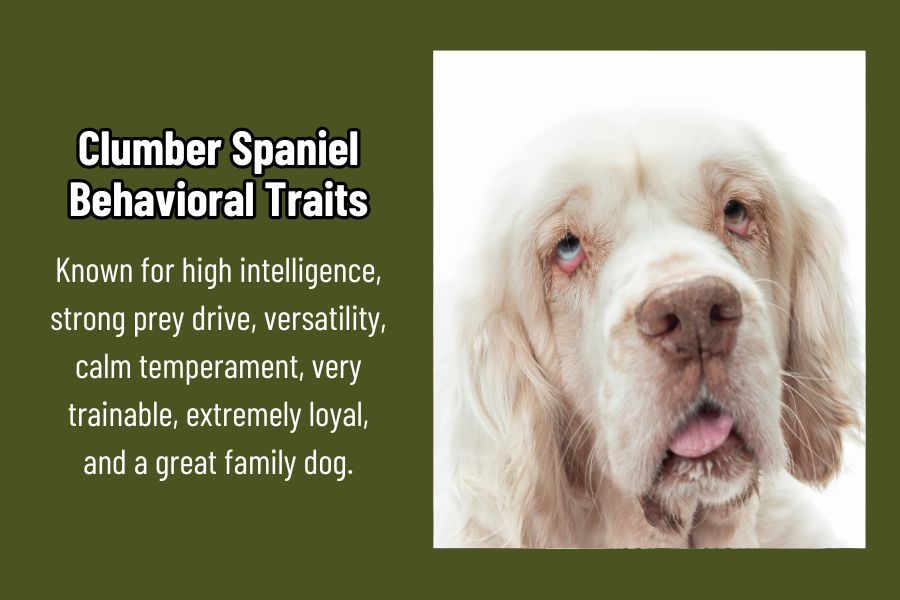
The Clumber Spaniel’s behavioral traits make it a strong partner in the field and at home. Let’s examine some of their key behavioral characteristics.
Prey Drive
Clumber Spaniels have a strong prey drive, which is a testament to their history as skilled hunting dogs. They were bred to locate, flush, and retrieve game birds, and this instinct remains deeply ingrained in the breed. They can easily get sidetracked on a strong scent when working or playing at home. Owners should be prepared to manage their prey drive with proper training and outlets for their hunting instincts.
Intelligence
Clumber Spaniels are highly intelligent spaniel dogs. This intelligence makes them quick learners, capable of understanding complex commands and tasks. Their problem-solving abilities are evident in their hunting capabilities, where they navigate dense challenging terrains and make decisions on the fly. This level of intelligence also means they require mental stimulation to prevent boredom, which can lead to undesirable behaviors.
Versatility
The Clumber is known for its versatility in hunting as well as other important roles. Whether it’s participating in search and rescue missions, working as detection dogs, or providing comfort as therapy dogs they are a versatile breed, capable of excelling in multiple areas.
Temperament
The Clumber has a calm and gentle temperament, making it an excellent companion for families and individuals alike. They are known for their affectionate nature and often form strong bonds with their owners. They are generally good-natured and get along well with children and other pets, provided they are socialized properly from a young age.
Loyal and Protective
Clumber Spaniels are known for their loyalty and protective instincts. They form strong attachments to their families and are often very devoted to their owners. While not typically aggressive, they can be reserved and protective of their home and loved ones. This loyalty, combined with their gentle nature, makes them reliable and trusted companions.
Family Compatibility
The Clumber Spaniel’s gentle demeanor and affectionate nature make them a great fit for families. They are patient with children and can adapt to different household dynamics. Their calm temperament means they are content to lounge around the house, but they need plenty of outdoor exercise and playtime.
How to Choose the Right Clumber Spaniel Puppy?
Clumber puppies are adorable. Choosing a Clumber puppy is a fun process but it can also be stressful. How do you know if you are selecting the right puppy? Here are some tips to help you make the right decision.
Investigate Breeders and Pedigree
The first step in choosing a Clumber puppy is to thoroughly research breeders. Look for breeders who are reputable and have a history of producing healthy, well-adjusted puppies. A good breeder will provide detailed information about the puppy’s pedigree, including health clearances for both the puppy’s parents and grandparents. This information is crucial as it can help you understand potential health issues and the lineage of your puppy. Visiting the breeder’s facility is also important to ensure that the puppies are raised in a clean, safe, and loving environment.
Assess Puppy Temperament and Behavior
When selecting a Clumber Spaniel puppy, it’s essential to evaluate the temperament and behavior of the puppies. Spend time observing how they interact with their littermates, the breeder, and new people. A well-socialized puppy should be curious, playful, and comfortable around humans. Avoid puppies that appear overly shy or aggressive, as these behaviors can indicate potential temperament issues. Interacting with the puppy directly can give you a good sense of its personality and how well it might fit into your home and lifestyle.
Check Health Status and Energy Levels
Health is a paramount concern when choosing a Clumber Spaniel puppy. Ensure the puppy has been vaccinated and dewormed according to the recommended schedule. A healthy puppy should have clear eyes, a clean nose, and a glossy coat. Check for any signs of illness such as lethargy, coughing, or diarrhea. Additionally, assess the puppy’s energy levels. While the Clumber dog is known for their calm demeanor, they should still exhibit a healthy level of activity and curiosity.
Caring for Your Clumber Spaniel
Proper care for your Clumber Spaniel is essential for their long term health. In this section, we provide some key guidance on how to keep your Clumber healthy and happy.
Nutrition and Routine Vet Care
Proper nutrition is vital for maintaining the health and vitality of your Clumber Spaniel. A balanced diet that includes high-quality protein, healthy fats, and essential vitamins and minerals is essential. Choose a dog food that is specifically formulated for medium to large breeds and consult your veterinarian to determine the best feeding schedule and portion sizes for your Clumber.
Schedule annual wellness exams to monitor your dog’s overall health. Consult with your vet regarding potential health issues prone to your dog. Stay current with vaccinations and preventative treatments for parasites like fleas, ticks, and heartworms. Regular dental care, including brushing their teeth and providing dental chews, is important to prevent oral health issues.
Exercise and Grooming Essentials
Clumber dogs have moderate exercise needs. While they are not as hyperactive as some other breeds, they still require daily physical activity to maintain a healthy weight and mental stimulation. Aim for at least 30 to 45 minutes of exercise each day, which can include walks, playtime, and engaging in scent and retrieving based games.
Grooming is also a crucial aspect of caring for your Clumber. Their dense, water-resistant coat requires regular brushing to prevent matting and to remove loose hair. Bathe your Clumber as needed, typically every few months, and ensure their ears are clean and free from infection.
Forging Relationship
Building a strong bond with your Clumber Spaniel is essential for their emotional well-being. Spend quality time with your dog through training sessions, play, and simply being together. Clumber Spaniels are known for their loyal and affectionate nature, and they thrive on human companionship.
Socialization is also key—expose your Clumber dog to different environments, people, and other animals to ensure they grow up to be well-adjusted and confident. Positive reinforcement training helps establish trust and respect between you and your dog, making them more responsive and well-behaved
Clumber Spaniel Training
Clumber Spaniel training is crucial to harness their full potential. Thanks to their intelligence and eagerness to please, the Clumber dog breed is highly trainable. Early socialization and obedience training are key parts of the training process. While they can be a bit stubborn at times, they respond well to positive reinforcement techniques and consistent training routines and commands. Here are 6 key control commands to help you get started training your Clumber Spaniel.
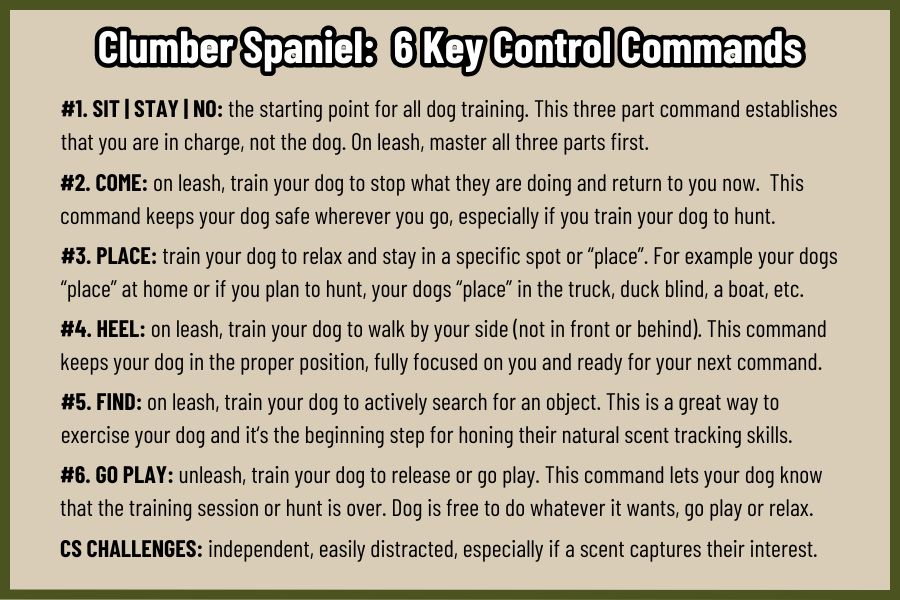
Stick to your Plan: Consistency is Key
Master the 6 control commands as illustrated above before you move on to more advanced commands. Consistency is vital when training a Clumber Spaniel. Establish a routine and stick to it, ensuring that all family members follow the same training methods and commands. Inconsistency can confuse your dog and slow down their progress. Use the same verbal cues and hand signals for commands to create a clear and understandable communication system. Regular practice and reinforcement will solidify their training.
When to Hire a Professional Trainer?
While many Clumber Spaniel owners can successfully train their dogs with patience and consistency, there are times when hiring a professional trainer may be beneficial. Consider seeking professional help if you encounter specific behavioral issues, such as excessive barking, aggression, or difficulty with basic commands.
A professional trainer can provide expert guidance and tailored training programs to address these challenges. Additionally, if you plan to engage in advanced hunting training or competitive field trials, a professional with experience in these areas can help refine your Clumber Spaniel’s skills and maximize their potential.
Conclusion
The Clumber Spaniel is a remarkable breed, known for its storied history, distinctive physical and behavioral traits, and versatility in various roles. From its origins as a noble hunting dog to its current status as a beloved companion, the Clumber Spaniel continues to capture the hearts of dog enthusiasts worldwide.
Whether you’re seeking a dependable hunting partner or a gentle family pet, the Clumber Spaniel offers a unique blend of loyalty, intelligence, and charm. Explore our blog for insights into other spaniel breeds and why they are excellent gun dogs.
FAQs: Clumber Spaniel
Are Clumber Spaniels high maintenance?
Yes, Clumber Spaniels can be considered high maintenance primarily due to their grooming and exercise needs. Their dense, water-resistant coats require regular brushing to prevent matting and to keep their fur clean and healthy. Additionally, they need consistent exercise to maintain a healthy weight and prevent boredom. Regular vet check-ups are also essential to monitor their health and catch any potential issues early.
Why are Clumber Spaniels so rare?
Clumber Spaniels are relatively rare, partly due to their specialized role as hunting dogs and their specific care needs. Breeders often focus on maintaining the breed’s health and characteristics rather than producing large numbers of puppies. This focus on quality over quantity, combined with their lower demand compared to more popular breeds, contributes to their rarity. Additionally, the breed’s slow reproduction rate, with smaller litter sizes compared to other dogs, also plays a role.
How much does a Clumber Spaniel cost?
The Clumber Spaniel cost can vary widely based on factors such as breeder reputation, pedigree, and location. On average, you can expect to pay between $1,500 and $3,000 for a Clumber Spaniel puppy. This price can be higher for puppies from champion bloodlines or with exceptional breeding credentials. Potential owners should also consider ongoing costs for grooming, health care, and maintenance.
Are Clumber Spaniels friendly dogs?
Yes, Clumber Spaniels are known for their friendly and affectionate nature. They are typically good-natured and get along well with children, other dogs, and even cats if properly socialized. Their calm and gentle temperament makes them excellent companions for families and individuals alike. However, their strong bond with their owners means they can be prone to separation anxiety if left alone for long periods and be somewhat aloof with strangers at times .
Are Clumber Spaniels good for duck hunting?
Clumber Spaniels are indeed good for duck hunting, thanks to their excellent scenting ability and strong swimming skills. Their large feet and powerful build make them proficient in retrieving waterfowl from ponds and rivers. While they are primarily known for upland game hunting, their versatility and steady nature allow them to excel in various hunting environments, including duck hunting.
What are the potential health problems with the Clumber Spaniel breed?
Clumber Spaniels can be prone to several health issues, including hip dysplasia, elbow dysplasia, and intervertebral disc disease due to their heavy bone structure. They are also susceptible to eye conditions like entropion and ectropion, as well as ear infections due to their droopy ears. Regular vet check-ups, a balanced diet, and maintaining a healthy weight can help manage and mitigate these potential health problems.
Resources: Clumber Spaniel
SPECIAL NOTE: “The information provided in this post is based on Google research and the Resource links listed below. While we try to keep the information for this post current, there are no representations expressed or implied, about the completeness, or accuracy of the information provided. Therefore all hunters should always verify current information from these resources along with other local and federal publications”.
Online Resources
- AKC – American Kennel Club
- TKC – The Kennel Club
- UKC – United Kennel Club
- CKC – Canadian Kennel Club
- CSC – Clumber Spaniel Club (UK)
- CSCA – Clumber Spaniel Club of America
Best Books
- “The Clumber Spaniel: A Comprehensive Guide to Owning and Caring for Your Dog” by Joan Hustace Walker: This book offers a thorough guide on the care, training, and history.
- “Clumber Spaniel (Comprehensive Owner’s Guide)” by Penny Parsons: A detailed book covering everything from the breed’s history and characteristics to training tips and health care.
- “The Clumber Spaniel” by Michael H. W. Russell: This book delves into the breed’s origins, development, and contemporary status, providing valuable insights for both novice and experienced owners.
- “The Complete Clumber Spaniel” by Judy Hill: An in-depth resource that covers all aspects of owning including breeding, showing, and everyday care.
- “Clumber Spaniel: History, Health, and Pedigree” by Sue Harrison: This book offers a comprehensive look at the breed’s history, common health issues, and pedigree information, making it a must-have for enthusiasts and breeders.

